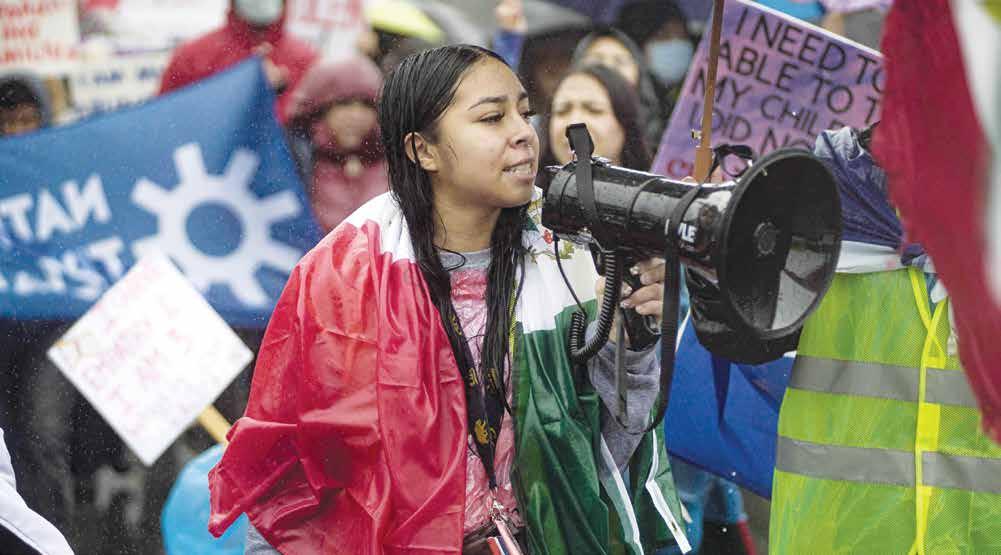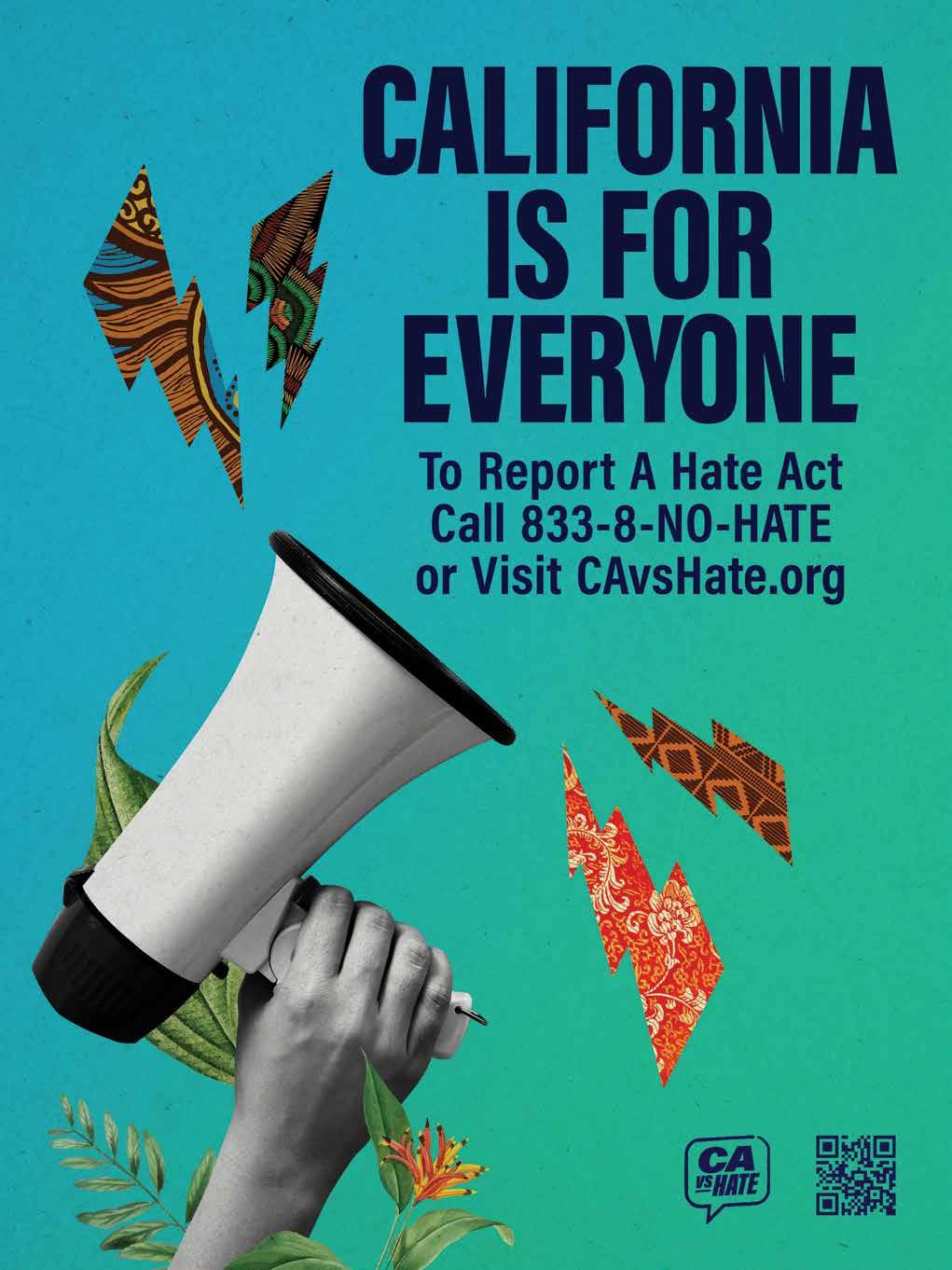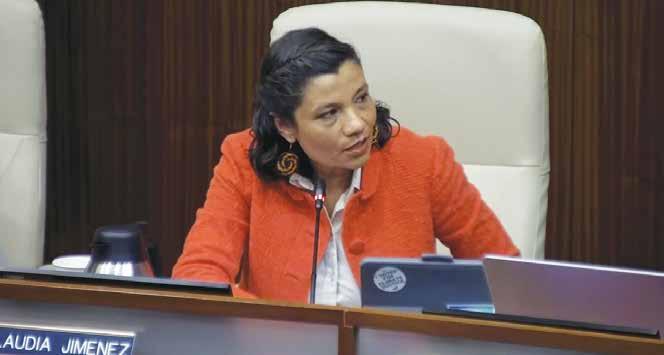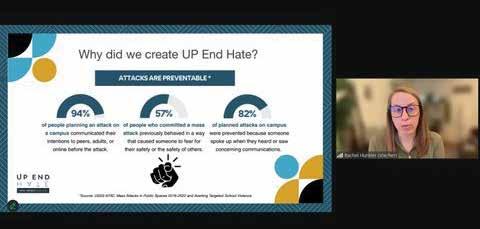





BY SAMANTHA KENNEDY
W
hen over 200 people, led by West Contra Costa Unified School District students and alumni, marched through the streets of Richmond in February, they sent a clear message of solidarity for their immigrant classmates and families, as fears over federal immigration enforcement continue to loom large in the East Bay.
In the wake of President Donald Trump’s executive orders on immigration, which have threatened to cut federal funding to sanctuary cities and end birthright citizenship, some school districts across Contra Costa County have taken steps to ensure the safety and security of their immigrant students. The threat of increased deportations and the administration’s decision to allow Immigration and Customs Enforcement activity in schools has raised concerns in local communities. These districts are now bolstering their protections and offering resources to reassure families that their children will be safe.
CONTACT US
Have questions, comments, or want to get involved? Contact us at:
info@ccpulse.org www.ccpulse.org
West Contra Costa Unified
Over 37% of those residing within WCCUSD’s boundaries, including in Richmond, El Cerrito, San Pablo and Hercules, were born outside of the country. Over half are Latino, according to census data.
Interim Superintendent Kim Moses said at a Feb. 12 school board meeting outlining the district’s response to immigration enforcement that raids are unlikely.
“Just to be crystal clear,” board member Demetrio Gonzalez-Hoy asked at the meeting, “if an ICE agent walks into the school, says they need to enter our school, our protocol is they’re not allowed to enter unless they have a warrant and that warrant has been reviewed by the superintendent’s office and a legal team.”
“That is correct,” said Moses.
Students have also shown up to support those who are affected. Just one week after Trump took office, Kennedy High alumna and UC Berkeley sophomore Ivonne Hernandez felt compelled to take action. She teamed up with another former Eagle and returned to their old
The Contra Costa Pulse is a community media project focusing on local and health news coverage in West and East Contra Costa County. The project is supported by STRONG Collaborative Fund.
school to engage current students in the “Immigrants Make America Great” march, held on February 2 in Richmond.
Moses said at the meeting that Michael Booker, the district’s safety consultant, had reached out to local police departments.
“We understand that some members of our community are fearful of law enforcement due to their immigration status,” the Richmond Police Department said in a February statement. “We want them to know the Richmond Police Department is committed to upholding our Sanctuary City policies and state law.”
That means, the department said, it will not question a person’s immigration status, does not participate in immigration raids, and does not detain individuals for civil immigration violations.
San Pablo’s police department issued a similar statement.
“I just want to make sure that we’re making it clear to our schools, our students, our staff that we have their backs no matter what comes from the Trump administration or anyone from the national level,” Gonzalez-Hoy said.
The district offers information in English and Spanish at wccusd.net/ immigration-resources.
The Pittsburg Unified School District amended its Safe Haven resolution at the beginning of the year to include that no state or federal funding will go towards assisting in federal immigration enforcement.
The resolution was first passed in 2017 during Trump’s first term to declare its “unequivocal commitment that every School District site shall be a safe and welcoming place for all students.”
PUSD, in collaboration with Stand Together Contra Costa, an organization that provides legal support and immigrant rights education, also hosted a free immigration clinic for community members earlier this year.
The event was one of some that Superintendent Janet Schulze previously said the district would organize “to provide our community with access to resources and information regarding their legal rights.”



BY GABBIE MUNOZ
The Alliance of Californians for Community Empowerment hosted a Know Your Rights workshop Feb. 27 at the Nick Rodriguez Community Center in Antioch, focusing on tenant and immigrant rights.
The event was part of a series of Know Your Rights workshops convened by ACCE to equip local communities with essential information on tenant protections, immigration issues, and available legal resources.
Leah Simon, legal director for ACCE, addressed the challenges that Antioch residents may face, not just from landlords but also in light of the new presidential administration.
During the conversation about tenant rights, Simon emphasized important local protections for renters in Antioch, including limits on rent increases and safeguards against tenant harassment and eviction without just cause.
Publisher Malcolm Marshall
Editor
Danielle Parenteau-Decker
Emily Molina
Joe Porrello
America Leon
Gabbie Munoz
Samantha Kennedy
Anushka Devanathan
Denis Perez-Bravo
Aina de Lapparent Alvarez
Vernon Whitmore
Sandy Close
Michael J. Fitzgerald
The Contra Costa Pulse is a community media project founded by New America Media, focusing on local and health news coverage in West and East Contra Costa County.
The project is supported by The California Endowment and the STRONG Collaborative Fund.
Have questions, comments, or want to get involved? Contact The Contra Costa Pulse at info@ccpulse.org www.ccpulse..org
“It’s important you don’t pay more than you have to, and make sure your neighbors aren’t either,” Simon said.
She also said that tenants should not face eviction because of racial discrimination or other reasons that are not legally valid. Furthermore, Simon noted that if a landlord wishes to bring someone else into a rental property, the landlord is required to cover the cost of relocation for the existing tenant, so they don’t end up homeless.
“These ordinances really came out of an awareness that when you have these policies, you can’t just evict people for no reason,” said Simon said. “And you can’t raise the rents to these obscene amounts.”
Simon also spoke about how migrants can protect themselves against landlords and what they need to be aware of.
“It’s illegal in California [for a landlord] to ask the tenant to provide information about their immigration status,” Simon said.
She also said that landlords are prohibited from threatening to contact Immigration and Customs Enforcement in an attempt to intimidate tenants.
On top of the tenant rights and protections, Simon discussed other rights that remain during a difficult time for immigrants.
“The Trump administration has created a lot of threats and made folks pretty uncomfortable and fearful and targeting people who are immigrants,” said Simon.
She explained that individuals have the right to remain silent when questioned about their immigration status.
“In California, you do not have to state your name, and you could just simply say, ‘I am exercising my right to remain silent,’ ” Simon said.
Simon also pointed out that if agents inquire about a person’s legal status, only those with green cards or visas are required to present their documentation. Citizens or undocumented individuals do not need to provide any documents.
However, recent changes in immigration enforcement in California have raised concerns among migrants.
“They weren’t doing it before, but … within 100 miles of the land and sea [borders] of the U.S … California immigration agents have the authority to stop you in transit for a search,” Simon warned.
Immigration agents also have the authority to board public transportation
and set up checkpoints to search vehicles. If detained, Simon advised individuals to ask why they are being detained and whether they are free to go.
Another warning that was given was about ICE agents being able to enter people’s homes.
“Immigration agents can enter onto private property, like your yard, but they cannot enter your home without a judicial warrant,” Simon said. “It is recommended you keep the door closed.”
Simon also said that if someone claims to have a warrant, individuals should ask to see it by having the agent slide it under the door or through a window.
In the event of an arrest, Simon recommended that you remain silent and refuse to sign any documents.
Patricia Aguilar, an organizer of the event, said workshops like this are important because this region of the county has a large population of immigrants, and ensuring that they feel comfortable attending and learning is paramount.
“I came here to learn,” said one attendee, whom we granted anonymity for their safety. “It has been very scary with everything going on, and I wanted to protect my family.”
Melvin Willis, an organizer for ACCE, said the goal of the workshops is to provide knowledge to individuals and give them the opportunity to be a part of something bigger and make an impact.
“With the new administration, we’ve seen a lot of families that get attacked just because of their status or color of their skin,” he said, “so we’re doing this to give people a chance to make sure they know what their rights are.” •
BY MALCOLM MARSHALL
Healthy Martinez and 350 Bay Area distributed free air purifiers to Martinez residents Feb. 22, following the Feb. 1 fire at the Martinez Refining Company. The fire forced nearby residents to shelter in place for seven hours as hazardous smoke worsened air quality in the area.
The two groups have been pushing for stronger protections and greater accountability from the refinery, owned by PBF Energy, since a November 2022 incident when the refinery released 24 tons of toxic spent catalyst dust across the area.
This marks the second air purifier distribution organized by the groups. In May 2024, they handed out 300 air purifiers door-to-door in Mountain View and Vine Hill, neighborhoods disproportionately affected by refinery pollution.
“This event is directly linked to the fire on Feb. 1,” said Zoe Jonick, lead organizer with 350 Bay Area. “Last year, we got a

donation of air purifiers and went door to door in the community to pass them out to people that are impacted by the poor air quality.
“We have 1,000 air purifiers that we’re handing out today because although [the] refinery should really should be the ones making sure that everyone has clean indoor air as a result of their pollution, they have not been doing that,” she said.
“So we are taking it into our own hands to make sure that people are protected with the air that they breathe in their homes.”
A diverse group of Martinez residents waited in a long line to receive the free air purifiers, expressing their gratitude.
Ayo Wachuku, a mother of two, was among those receiving a purifier.
“Martinez is a small town but close to big cities,” Wachuku said. “My kids are involved in local activities, and we love the sense of community here.”
Her daughters are sensitive to dust and smoke. After seeing a flyer for the air purifiers, she decided to get one.
The fire occurred on one daughter’s
10th birthday, and Wachuku recalled seeing black smoke while driving home from Concord.
I just packed my things as soon as possible and just took my kids away from the house so they felt safe,” she said.
Wachuku hopes the refinery will take more responsibility.
“Just be more responsible,” she said. “Some of my neighbors work there. I just want [the refinery] to be accountable.” Through actions like the air purifiers giveaway, organizers aim to address the immediate impact of hazardous air quality on residents dealing with frequent incidents.
“Our community doesn’t trust PBF Energy and the Martinez Refining Company,” said Justin Gomez, a member of Healthy Martinez, in a statement.
“Until we can see policy shifts that disincentivize operational cultures that allow repeated large scale incidents that harm workers and Martinez residents, we have to make sure we are doing what we can to prepare for the next one — it feels inevitable.” •

INTERVIEW • MALCOLM MARSHALL
Reimagine Antioch organizer Teki Flow’s work is centered on uplifting voices of residents while holding city officials accountable.
According to its Facebook page, the advocacy group believes “public safety means access to fair housing, quality food, safe and clean community spaces, healthcare services including mental health care, and economic opportunity.”
Flow’s commitment to justice is rooted in her upbringing in Detroit, where she was involved in the Rosa Parks Pathway to Freedom program. Describing herself as a disruptor, she is not afraid to challenge the status quo and fight for a community that values equity and fairness.
In this interview, Flow shared her thoughts on the ongoing struggles in Antioch and her work to bring about real change for residents. This conversation has been lightly edited.
CC Pulse: Tell us about Reimagine Antioch and the work that your organization is doing in the community, particularly for Black residents? What inspired you to get involved?
Teki Flow: Reimagine Antioch brings voice to the community. We have been able to help advocate for things like body cameras, advocate with ACCE [Alliance of Californians for Community Empowerment] and [Rising] Juntos for rent control. We also brought attention to the police officers text message scandal when it came out.
I started building relationships in the community by holding Thanksgiving and Christmas events and things like that. We did backpack events just to get word out and talk to the community and see what the community wanted from us.
From that point on, we were advocating and making sure that the people’s voices were heard. It was like I told you so, because the community had already been telling us. The community had already been marching and everything. I just came in, and I wasn’t scared to be that disruptor. I wasn’t scared to help the community get their word out about the police officers.
We had a few demands and one of them that was met was the Antioch Police [Oversight] Commission. We fought to get that open.
When Trump got elected the first time, that’s when I decided to actually jump in and do something. My sister ran into Tamisha [Torres-Walker] and she introduced her to the Collective Impact class, which she told us about because my husband was formerly incarcerated and I was impacted. My husband and I decided to take the class. That’s when I learned the basics of organizing. And at that point, what I was hearing here in Antioch from Black folks that the police officers were doing them wrong — actually not only Black folks, you had Native Americans and Mexicans. Also, I was trying to figure out how can I not be homeless anymore because of my husband’s former incarceration. They wouldn’t allow us into the apartment. We had the money and everything, but because his background was six years and not seven, we couldn’t get into that space. So Tamisha was like, “You need to go and see what they’re talking about at the City Council.”
At City Council, Kathryn Wade’s story


is what activated me. When Ms. Wade got up there, I was like, there’s something I could do, but I don’t know what it is. Tamisha told me, “You got to learn how to organize. You got to keep doing what you’re doing so you can help the community get their voice out.” And that’s what I did. I continued to join different cohorts like SpadeWork and learned. Then, I got involved with the Office of Racial Equity and Social Justice as a corps member at the beginning. We had community forums about why folks wanted the Office of Racial Equity and Social Justice.
CC Pulse: What specific challenges are you hearing that Black residents in Antioch are facing?
TF: When I’m talking to Black people in Antioch, I’m hearing people focused on their children and their education. Also, the lack of anything to do here in Antioch for their kids. If they don’t have anything to do, then they’re going to be in trouble, because I have to work, because rent is sky high. They not working one job; they are working two jobs. So that’s one of their main concerns. People are struggling financially, and they are thinking about their kids and the future.
Because I am from Detroit and now living I’m here, I can compare and say that I have never struggled so hard in my life like I have here in California. I had never been homeless before.
CC Pulse: As a Black leader in the community, what has been your journey in advocating for change, and how has your understanding of Black history influenced your activism?
TF: I’m always thinking about, would I have been marching with Malcolm X, or would I have marched with Martin Luther King? I think I would have marched with both, but if I was marching with King, I couldn’t let them attack me, so I would have went to jail, or I wouldn’t have made it too many marches. I probably would have been with Malcolm X because I want to scream and shout in this time that we’re in.
So I’m taking strength from the ancestors, knowing that they did this in much more dire circumstances than we’re in. I’m excited just to be able to walk in their shoes. I’m excited to get ready and try to boycott and do it as a community, and I’m pulling energy from my ancestors.
BY SAMANTHA KENNEDY
Amonth after Mayor Ron Bernal proposed a pause for the Antioch Police Oversight Commission to refine onboarding and training, commissioners indicated they won’t give in to the pressure just yet.
Commissioners at the March 17 meeting did not reach a consensus that would have either reduced the number of monthly meetings or halted meetings indefinitely. Much of the opposition to a pause was because of claims the council is exercising its political power over an independent commission.
CC Pulse: They were both disruptors, in their own ways. That’s why both of them were killed. If they weren’t disrupting, they’d probably be alive now.
TF: I’m taking an ethnic studies class, and I think a lot of our Black leaders — we have a lot of strong people in our community, but some of them might be fearful, because of the white people beating us up and tearing us down and burning our whole communities down or whatever — they are probably like, let me get my stuff, do what I do, and take care of mine.
I’m really hoping, not just Black people here in Antioch but everywhere, that we can just come together and be on one accord like our ancestors. Freedom was in mind and they meant that, and I [want] all of us … to really open our eyes and see that people are after us.
CC Pulse: As you reflect on your work with Reimagine Antioch and the progress that’s been made, what changes or achievements are you most proud of, and what’s on the horizon for the group?
TF: What activated me was Ms. Wade and her story. She had been trying to get them to listen to her, but they wouldn’t listen to her. They were saying she was crazy. We had three or four healing events, and Ms. Wade was really a big part of it. If she wanted to cry for her son, she was able to do that in that space. So that’s my most proud moment. She [got a settlement from the city], and now people have to believe her, because her son’s name and what they did to him is in the text messages.
There’s a lot coming up for Reimagine Antioch, because we have this political landscape that we’re in, and I don’t think any of us can sit still. So we’re revamping, but we’re still concentrating on making sure that we have equity in our police department and making sure they are being held accountable. We’re going to continue to create safe spaces and have our healing events. And it’s not just healing from the police officers — people just need to heal period. I’m looking forward to Reimagine Antioch, working really closely with our City Council and watching the budget, because we have three new council members, and we have two council seats that will be up the next two years. •

“It’s imperative our work continues uninterrupted and to uphold its mission of independent oversight and public accountability,” said commissioner Treva Hadden.
Although no decision was made, a commissioner-led proposal to reduce meetings from twice a month to once a month may be considered in the future. Talks of a potential pause come after the resignation of former commissioner Leslie May, which put the city out of compliance with a U.S. Department of Justice agreement. It mandates that the commission must have at least five of its seven seats filled. As of press time, only four members are seated.
Bernal’s proposal in February would have stopped meetings until June to allow new commissioners to be interviewed and trained with current commissioners. However, the City Council cannot pause APOC’s meetings without rewriting a city ordinance. City staff is drafting new language for the ordinance, according to Assistant City Attorney Kevin Kundinger. Chair Porshe Taylor said that while interviews are reportedly ongoing, the training timeline — and the length of a potential pause — is still unclear.
Since the commission’s first meeting last March, over one-third of its meetings have been canceled or postponed because they either failed to reach a quorum or fell on a holiday.
Commissioner Alicia Lacey-Oha said she was disturbed that the March 10 meeting, where the agenda was identical to that on March 17, failed to reach a quorum and suggested alternates be named to ensure meetings take place. With only four members, the commission also must approve any item unanimously to pass an agenda item. Even a 3-1 vote would not be enough.
An independent commission
Some community members who spoke in opposition to the proposed pause said the commission should be free of political interference and claimed council members had silenced commissioners.
“It felt like you guys gave in. They said ‘dismantle’ and you guys said ‘OK, we agree.’ I’m speaking for the community, for African Americans. You didn’t stand for us,” ” said Teki Flow of Reimagine Antioch. “Please, I beg you to fight for your community before putting your hands up.”
Some advocates have expressed concern the commission would be eliminated since Bernal, Mayor Pro Tem Louie Rocha and council member Don Freitas took office in December. Their arrival meant the end of a progressive majority on the council.

The Pittsburg High Pirates' J’Marion Bella got four hits — including a bases-clearing triple — drove four runs in and scored three as Pittsburg beat De Anza High 12-1 in five innings on March 7.
In their first road game of the season, Pittsburg High stormed into Richmond on March 7 and defeated De Anza High 12-1. Six different Pirates recorded hits and runs batted in, and seven scored.
The win kept Pittsburg’s varsity baseball team unbeaten to start the year. Meanwhile, De Anza entered the game winless, having been outscored 26-7 and losing six straight dating back to last season.
Game highs in runs, hits (10), walks (8), hit-bypitches (3) and extra base hits (3) helped Pittsburg to their largest margin of victory this season despite umpires ending the contest after five innings due to the one-sided score and limited sunlight.
Four De Anza errors contributed to their most runs allowed and biggest loss of the season.
“In the start of the season, sometimes it’s hard to get in a groove — there’s anxiety and nerves, and it takes a little bit to settle in,” said first year Dons head coach Jeron Davis, who has been with the team since 2018.
Previously, Pittsburg had beaten De Anza five times in a row over 18 years by a combined score of 66-14. However, the Pirates lost to the Dons last March 10-1.
“We kind of wanted to return the favor this year — we got them back,” said Pittsburg head coach Marco Cartagena, now in his 11th year.
In the first inning, after a leadoff double by Pittsburg, two flyouts to the warning track helped De Anza escape
the frame without allowing a run. It was the only inning without a run for the Pirates.
De Anza took a 1-0 lead after back-to-back two-out doubles in the bottom of the first. But that would be the Dons' only offense, as they failed to get a hit or score again, going down in order every remaining inning.
Two second inning Dons errors — one throwing and one fielding — aided the Pirates in breaking through for their first run. Another pair of warning track flyouts temporarily maintained the tie and kept Pittsburg without a home run this season.
The Pirates pulled ahead 3-1 in the third with an RBI single and a bases-loaded hit-by-pitch. Brothers and Pittsburg teammates Paul and Santino Salazar were plunked with the bases full in back-to-back innings.
Pittsburg added four more runs in the fourth, helped by a pair each of RBI singles, walks and doubles, including a two-RBI double by Diego Deluna. He also scored twice.
The Pirates were far from finished. They tacked on five in the fifth with a two-RBI single by JD Wilson and a three-RBI triple by J’Marion Bella.
Bella also had three singles, three runs and a fourth RBI. Devin Simonton, who entered the game with a team-leading .462 batting average, contributed a single, two walks and two runs. Senior JJ Robinson chipped in with a double, two singles and two runs.
“I was just trying to be aggressive and let my hands fly,” said Robinson.
Pittsburg starting pitcher Desmond Toomer, who
entered the game with a team-high 14 strikeouts, earned his first win of the season.
After 13 straight losing seasons from 2004-17, Pittsburg has turned it around. With 20 wins in each of the past two years, the Pirates are on track for their fifth straight winning season.
De Anza, which had only one losing record in the past seven years (during the COVID-19-shortened 2020 season), is off to its worst start in a decade after losing three coaches and several starters — two of whom received college scholarship offers.
“They were a big part of our team,” Davis said.
The following day, Pittsburg shut out Kennedy High of Fremont 11-0, improving their record to 6-0, their best start in over 20 years.
“We didn’t have too hot of a start last year, but this year we’re ready — everyone’s confident and flowing,” said Pittsburg senior Ty Thompson, who notched his team-leading seventh RBI.
Davis, the Dons’ coach, hoped his team could regroup after the loss and bounce back after a slow start as they’ve done before. Last year, the Dons lost three of their first four games but still managed a winning record after taking five of their final seven games.
“We need to get back to practice and focus on the little things — have fun — and it will work itself out,” said Davis. “This is just one blip on the radar; I’m staying focused on making sure they play for each other and give their best [effort].”





BY JOE PORRELLO
About a year ago, director Alex Zajicek finished his first feature-length film, “Sorry, We’re Dead,” shot mostly In West Contra Costa County where he grew up and still lives. It was the first movie filmed primarily in El Sobrante in about 70 years, since the days of the old Park Theatre.
The film has been screened at nearly 20 film festivals, won multiple awards, and become available on top streaming platforms, as well as in physical form.
Zajicek’s favorite screening was the most local, at SF Indie Fest.
“We basically sold out the Roxie Theater — it was a great time,” he said.
At the Seattle Asian American Film Festival, “Sorry, We’re Dead” won the award for Grand Jury Bes Narrative Feature. At Michigan’s Royal Star Festival, it took home the prize for Best Feature Film; at the Comedy Film Festival in Austin, Texas, Best Belly Laugh.
In addition, the film’s star Sara Lee earned a nomination for Breakthrough Female Performance at the NYC Festival of Cinema.
But the rest of post-production was not as rewarding.
“The distribution process is difficult and complex,” said Zajicek. “Most filmmakers I talk to don’t like their distributors.”
He says many directors are promised payments of profit percentages that never come — regardless of a movie’s popularity — while forfeiting ownership of their creation.
“I definitely had a fear of selling my film and losing all control over it,” said Zajicek.
Instead, he used a platform called FilmHub that he says is most highly regarded among indie filmmakers because it takes the smallest fees, is most transparent with the film’s viewing and purchase numbers, and lets directors maintain ownership of their product.
“You do more work like creating posters and providing them with copy, but they do the work of pitching the film to various streaming platforms,” said
Continued from page 1
In a statement, the Pittsburg Police Department said in February it does not participate in immigration raids, does not ask about immigration status, and does not arrest individuals based solely on federal immigration detainers.
PUSD offers info in English and Spanish at pittsburgusd.net/Programs-Services/Community-Engagement/SafeHaven-Resolution-Resources.
Antioch Unified
The Antioch Unified School District unanimously reaffirmed its commitment to all students and their learning no matter their immigration status at its Jan. 29 board meeting.
The resolution first passed in a 3-2 vote in 2017.
The district has also offered guidance to its staff on responding to potential immigration raids.
“We are committed to fostering safe learning environments, protecting student information, providing support and resources, and standing in solidarity with our students,” the district wrote in its guidance for school sites.
In that guidance, school sites are told to go through a series of steps if an immigration agent shows up.
Staff first notifies the principal. The principal must then notify the district office and verify the agent’s credentials and legal documents. The principal must

Zajicek.
And more work is exactly what Zajicek did.
With the film available to stream on major platforms such as the Roku Channel, Tubi, Apple TV and Amazon Prime Video, his next goal was to release “Sorry, We’re Dead” in physical format.
Doing all the artwork, coding, and design himself — while using out-of-date technology — Zajicek spent weeks going back and forth with Adobe customer support to make everything come together.
“It was ultimately a big mess just to get the software running, and then there were so many other layers of problems,” he said. “Even just deciding deleted scenes ended up being way more complicated than I thought.”
Other than graphic design advice and a sourced disc and case printer, Zajicek made the DVD and Blu-Ray combo product almost entirely himself.
“It was either going to be me, or it was going to be spending a bunch of money that I didn’t have because I just spent it making the movie,” he said.
Indeed, any post-production costs were paid by Zajicek.
“Whatever money I’m putting in is essentially being thrown into a black hole, and I’m not expecting it to come back,” he said. “Almost no film is profitable — the ones you hear about are, but that’s only less than 1% of films made.”
Of the more than 20 film crews Zajicek has been a part of, he says none have made a significant profit, if any. Getting the film on hard copy was important to
again contact the district office, according to the guidance, to review the legal documents.
“To the extent permitted by law,” the district says, “restrict sharing of student and parent/guardian immigration status with federal agencies or officials.”
Similar to Pittsburg, Antioch is not a sanctuary city like Richmond or El Cerrito. But California is a sanctuary state and already has limits on how resources at the state and local levels can be used in immigration enforcement.
Dozens of Antioch residents marched days after the February protest in Richmond, with council member Tamisha Torres-Walker, who has called for Antioch to be a sanctuary city, showing up.
The Antioch Police Department said in a February statement it does not participate in ICE raids, does not ask individuals about their immigration status for enforcement purposes, and does not detain individuals for civil immigration violations.
The school district provides information in English and Spanish at antiochschools.net/page/immigration.
All Contra Costa County residents can also visit Stand Together Contra Costa, a no-cost program that provides rapid response support, legal support and immigrant rights education. •
Continued from page 3
Zajicek both to reach a larger audience and for nostalgic reasons.
“I made the decision partly because I loved physical media when I was young,” he said, “the commentary tracks and just kind of learning about the process behind the scenes — I wanted to do the same thing with my film.”
The two-disc multiformat version of “Sorry, We’re Dead” includes not only deleted scenes but also director and cast commentary, bloopers and two of Zajicek’s short films.
He also printed the movie onto discs to preserve it.
“I feel like in this all-streaming world we live in, so many projects get deleted from catalogues,” said Zajicek.
After writing the first draft about a decade ago, he says finally holding the finished product in his hands felt like a good ending point for the project.
“This is the bow and kind of a sense of accomplishment,” said Zajicek. “I can move on to the next project and know this one is done.”
He hopes to start shooting his next film this year — if finances allow — but he’s still soaking in his achievement of movie No. 1.
“I achieved a life goal; making a feature film is something I’ve wanted to do since I was a kid,” Zajicek said.
“Sorry, We’re Dead” can be purchased at www.aqlex. com/sorryweredead or at Pegasus Books in Berkeley and rented at Video Vortex in San Francisco. •
“It’s no secret the mayor in office and certain council members do not want the APOC to exist, yet we have (commissioners) here engaging in personal matters with our City Council, mayor,” Hadden said. “And another (commissioner) who followed the mayor’s directive to oust former commissioner Leslie May.”
May, who said March 17, that her resignation was forced after Freitas called for her removal, said it was important the commission continued without interruption because the world was watching.
May resigned after using the n-word when speaking to city leaders during a special City Council meeting while she was protesting the potential firing of former city attorney Thomas Lloyd Smith.
In response, Commissioner Lacey-Oha dismissed claims that Bernal had been influencing commissioners.
“The only person who has been talking in my ear is God,” she said. “I’m here for the best interest of you all.”
Vice Chair Devin Williams echoed Lacey-Oha, saying his intentions were to ensure things were community-led.
The next Antioch Police Oversight Commission meeting is April 7. •



BY DANIELLE PARENTEAU-DECKER
The Trump administration’s increased enforcement of anti-immigrant policies has many living in fear, but advocates are working to ensure immigrants know their rights.
Ethnic Media Services hosted a panel of experts Feb. 7 to discuss how individuals should respond if approached by immigration officials at home, work, or school — or if they are arrested.
“As undocumented people in the U.S., we are still entitled to constitutional protections,” said Amanda Alvarado-Ford, deputy directing attorney of the Immigration Institute of the Bay Area. That includes the right to remain silent and freedom from unlawful search and seizure.
ICE at Your Door
If Immigration and Customs Enforcement agents come to your door, don’t open it unless they present a judicial warrant signed by a U.S. district court judge, according to Alvarado-Ford.
Ask if the agent has a warrant and request to see it. You can ask them to slide it under the door, pass it through a mail slot, or hold it up to a window.
Examine the paperwork closely. “You want to scrutinize that carefully and not feel rushed as hard as it might be,” she said. “We have to remember to breathe and remember our rights and remember we’re looking for that signature from a judge from a U.S. district court.”
This is important because they might show you official paperwork, just not the right kind.
“Most times, it’s an ICE immigration official who has signed an ICE/Department of Homeland Security warrant for alien arrest, which is not a signed judicial order,” Alvarado-Ford said.
A proper judicial warrant will state “United States District Court” at the top and include a judge’s name and signature. The ICE/DHS order will say “warrant for arrest of alien,” but it does not actually grant the authority to arrest someone.
Without a judicial warrant, Alvarado-Ford advised saying: “I would like you to leave the premises. Please leave. I have the right to remain silent, and I also have the right to speak to my immigration attorney.”
She also said to say the last part even if you don’t have an attorney yet.
ICE at School or Work
Viridiana Carrizales, founder of ImmSchools, said that 5.5 million children in the U.S. are undocumented or

live with an undocumented parent, though most of these children are U.S. citizens.
Current anti-immigrant policies are causing “a lot of fear in immigrant parents who are questioning now whether or not they should bring their kids to school,” she said. “Some parents have already withdrawn their kids from school.”
Carrizales urged parents to “be aware, be alert, be safe,” but emphasized that children should still have access to education.
In 1982, the Supreme Court ruled in Plyler v. Doe, “every child in this country, regardless of their immigration status, regardless of their parents’ immigration status, [has] the legal right to be in K-12 schools,” she said.
Carrizales, an undocumented student herself, remembered the fear she felt.
“When I got here to the U.S.,” she said, “one of the first things that I learned very quickly, it was that schools were not safe for me, and the schools were not safe for my parents.”
She started her organization eight years ago “because no kid should ever be afraid of our schools. [They] should never be afraid of the same places that are meant to protect them.”
She’s made it her work to train educators and give information directly to students and families “to ensure that they know those rights and they’re able to exercise those rights.”
Carrizales said the Family Educational Rights and Privacy Act “protects the privacy and confidentiality of our students’ records. Any information that a parent shares with a school is protected under this privacy act.”
Immigration officials can only access a child’s school records with a judicial warrant, which they “almost never” have, Carrizales said. “If an immigration official has an arrest warrant, an administrative warrant, something that is not judicial, that does not give them the authority to get information from our kids,” she added.
Such warrants may also only allow searches of specific school areas.
She also said that schools should only have legal
counsel interact with immigration officials “so they can verify the validity and the legality of the documentation that they are presenting.”
Schools have indeed become less safe for immigrant families since the Trump administration rescinded the so-called sensitive locations memo just hours after his inauguration. The memo, which was signed by thenSecretary of Homeland Security Alejandro N. Mayorkas in 2021, prohibited immigration officials from making arrests at or near specific places, including schools and places of worship.
But the protections under Plyler v. Doe and FERPA remain, Carrizales said. And schools are never supposed to know their students’ immigration status.
“A school cannot require, cannot ask (for), cannot collect or document any information regarding a student’s immigration status,” she said. “A school cannot ask a parent, ‘Are you undocumented? Is your kid undocumented?’”
Alvarado-Ford reminded people that ICE can only enter areas open to the public at a workplace, not private or employee-only spaces. Again, they can only arrest someone with a judicial warrant.
Arrested by ICE
If arrested by immigration officials, Alvarado-Ford stressed the importance of asserting the right to remain silent.
“We can assert that right in a respectful way,” she said, “and I would recommend a respectful tone so as to avoid any undue harshness on the part of an ICE agent.”
Additionally, tell the agent if you fear returning to your home country or if you’ve been in the U.S. for at least two years. This entitles you to a hearing. Keep any documents that prove your length of stay in a safe place for easy access, she said.
She also recommended being prepared to show proof if you’ve applied for asylum, a U visa for victims of certain crimes committed in the U.S., a T visa for trafficking victims, or a green card under the Violence Against Women Act. Keep receipts or photos of these documents on your phone for easy access. •


PHOTO ESSAY • EMILY MOLINA
Moving to a new city can be an anxious experience.
It’s often difficult to develop a sense of connection when you’re unfamiliar with a place’s traditions and history. As someone who’s lived in several cities across the Bay Area, I’ve found that a city’s character plays a big role in helping you call a new place home.
Now that I’m a new resident of Pittsburg, I’m still navigating the different communities that make up the essence of this town. One way I’ve found to engage with my new environment is through the art murals found around town. For me, these murals serve as a bonding experience, allowing me to identify with the community and feel connected to its identity.
Below are four murals in Pittsburg that have helped me feel a sense of belonging and have taught me valuable lessons as I settle into my new home.
The Creation of Adam Mural – Crestview Drive
Whenever I take a walk around my neighborhood, I pause to admire a mural inspired by Michelangelo’s “The Creation of Adam.” Located on Crestview Drive, across from Woodland Hills Park, this mural is one of my favorites. It serves as a reminder to reflect and appreciate the peace of my daily walks. The calming backdrop of
the towering green hillsides along Kirker Pass adds to the serenity, and seeing the mural makes me feel grateful for the quiet, pleasant neighborhoods in Pittsburg.
Heritage Park Plaza Mural – Old Town Pittsburg
For those who want to learn more about Pittsburg’s deep sense of community, the mural at Heritage Park Plaza in Old Town is a must-see. The mural beautifully depicts themes of familial bonds, historical pride, and community prosperity — values passed down through generations of Pittsburg residents who have made this town special.
As a newcomer, I find myself identifying with one section of the mural in particular. It shows a newly arrived family with their belongings, transitioning into a photograph of a wedding. To me, this symbolizes establishing generational roots and family bonds — something I hope to do here in Pittsburg as well.
The mural at Historical Park Plaza is mesmerizing, as many of the events it depicts resonate with my own journey of starting a new chapter in Pittsubrg.
Indigenous Heritage Mural – Railroad Avenue
Another mural I enjoy is located on the side of the Ace Hardware building on Railroad Avenue. This colorful piece honors the Indigenous heritage of the Pittsburg

area, specifically the Bay Miwok people who lived here long before European settlers arrived. The mural acknowledges the lives of these Indigenous groups, whose cultures were reshaped by newcomers. Today, these blended cultures coexist, a reality the mural beautifully captures.
Latino Heritage Mural – Cardenas Market
Lastly, there’s a stunning mural on the history of the Latino identity, located on the back of the Cardenas Market near the highway entrance. This series of murals chronicles the pre-history, transformation, and ongoing cultural presence of the Latino community in Pittsburg. As someone who shares in that heritage, I find it deeply meaningful to see it proudly displayed as visitors enter the town. It’s a visual welcome that makes me feel connected to the city and its values.
These murals have become my way of bonding with Pittsburg, offering me a sense of belonging and helping me appreciate the town’s rich history. They serve as both reminders of the past and invitations to become a part of the ongoing story of this community. I encourage everyone to walk through their city, or any new town, and explore public art to better understand the community’s identity.







BY SAMANTHA KENNEDY
While President Donald Trump addressed Congress on March 4 again saying he plans to “complete the largest deportation operation in American history” and touting the bill that requires detention of undocumented residents accused of theft and violent crimes, Richmond decided to lend immigrants close to home $1 million in support.
The Richmond City Council agreed to move forward with allocating $1 million from the city’s surplus fund for immigrant legal services, including a public education campaign.
Trump, who called his wide-ranging policies on immigration, among others, “swift and unrelenting,” has made immigration a top priority. That has meant the Laken Riley Act, threats to federal funding for sanctuary cities, attempts to end birthright citizenship and more.
“There is a lot of fear, a lot of miscommunication, a lot of things that our city needs to stand together and support our community,” said council member Claudia Jimenez. “The right thing right now is to — as leaders on the Richmond City Council — stand together against hate and racist policies.”
The funding, proposed by Jimenez, Vice Mayor Cesar Zepeda and council member Doria Robinson, will come from the city’s 2023-24 surplus fund, according to City Manager Shasa Curl. (While the accompanying agenda report refers to a 2024-25 surplus, Curl corrected the year before the council voted.) It also earmarks $10,000 to provide free municipal IDs to residents, building on a separate agenda item council member Soheila Bana brought forward that same night.
The city will now choose a fiscal sponsor that will distribute funds to nonprofit organizations that will provide those services. The contract for that sponsor is set to come back at the April 15 meeting.
Local organizations already supporting legal services for immigrants were among more than a dozen who spoke in support of the funding, saying Richmond’s immigrant community was left vulnerable by anti-
BY DENIS PEREZ-BRAVO
Kennedy High School students organized two days of walkouts to protest budget cuts they say will disproportionately affect their school and educational opportunities.
The two-day action began with a walkout March 11 morning and culminated in a march March 12 to the West Contra Costa Unified School District offices on Bissell Avenue in Richmond.
"It feels really great. I feel really honored to organize this walkout with other students," said Josue Enamorado, a Kennedy High School sophomore.
"Most of the teachers here, like Ms. Perez, Mr. Taylor, Ms. Hernandez and many others, really care for this community, especially Kennedy."
The WCCUSD board voted Feb. 26 to proceed with cuts to over 150 positions as part of its fiscal solvency plan. This decision has sparked strong opposition from both students and the United Teachers of Richmond union, which represents educators throughout the district. And it came just three weeks after the board

immigrant policies on the federal level.
“They are our fathers and mothers. They are our children, our neighbors and our friends. They are leaders in our Richmond community,” said Tomasa Espinoza, a member of Rising Juntos, in Spanish. “Legal services are essential to winning an immigration case, but these are scarce and that is why they need to be expanded at this time.”
Reimagine Richmond’s Marisol Cantu said the group has trained over 1,200 county residents in six weeks during Know Your Rights trainings.
Reimagine Richmond, the RYSE Center, Contra Costa Health and Stand Together Contra Costa have also partnered with the West Contra Costa Unified School District to offer resources to families.
Supervisor John Gioia, who represents Richmond on the Contra Costa County Board of Supervisors, said there’s been an increasing demand for immigrant legal services since Trump took office.
“This is about protecting families and protecting our economy,” said Gioia, referring to more than 30% of the county’s population being immigrants. “It is disrupting their families, it affects their desire to come in and get services, whether it is health services or social services.”
Since Trump’s inauguration in January, the Stand Together Contra Costa hotline has increased by 330%, according to director Ali Saidi.
A couple of speakers questioned how effective $1
approved $13 million in cuts over the next two years, which would mean the elimination of 90 positions, including 17 classroom teachers. Those cuts were in addition to $19 million in budget reductions that already been made this school year.
The day before the Feb. 26 vote, union leaders spoke to Richmond City Council, asking it to examine the district’s finances, though the council holds no authority over the school district.
The cuts have been years in the making.
In 2023, then-associate superintendent of business services Robert McEntire said a fiscal solvency plan with significant budget cuts was necessary at a time in which the district was at risk of being forced to cede financial decision-making to the state. That followed a 2021 report in which the state Financial Crisis Management Assistance Team projected that the district would become financially insolvent because of deficits in the millions caused by overspending.
Enamorado expressed frustration that Kennedy appears to be taking the brunt of the cuts compared with other schools in the district.
"Other schools like El Cerrito, Hercules, and many other schools have so many great programs,” he said. “And it’s just us who are going to get the majority of the cuts, especially the majority of the electives here."
Jasmine Sanchez, a senior at Kennedy, shared similar concerns about the cuts to vital programs.
"We're fighting back on the budget cuts that are going on within our district, especially at the school," Sanchez explained. "Many of my programs and our teachers' really good programs that support students are being cut, and there's really no reason for it."
Sanchez also referenced the so-called Fund 17, describing it as a trust fund where the district "put a bunch of money in for no reason" while simultaneously cutting programs students rely on.
Some opposed to the cuts have said they are unnecessary because, they say, the district has
million in funding would be against federal policies, if the funds should be used elsewhere and accountability surrounding the use of the funds.
“There is always something else,” said Zepeda, who spoke of his father’s story as a previously undocumented immigrant. “Can we use it for roads? Yes, but imagine an empty road because our families and neighbors have all been taken.”
Council member Jamelia Brown, who supported the proposal, also wondered how the funding would be used most effectively. That meant having data — “how do we track that people are not being left out?” she asked.
Deported Richmond residents and how many undocumented residents are using current services are not tracked by the city, but Jimenez said she hopes the chosen sponsor is an experienced Richmond-based one that can choose nonprofits able to deliver on the funding’s goals.
Nationally, federal data shows that over 22,500 people have been arrested by the U.S. Immigration and Customs Enforcement, or ICE, over the previous month.
“The data that we do have is the reaction from the community,” said Mayor Eduardo Martinez, referring to February's 23rd Street march and interfaith immigration vigil. “The community has activated their concerns … so we need to show people that we are supporting them in their need for existence in our society without fear.” •
$162 million in its reserves, but interim WCCUSD Superintendent Kim Moses told the school board Feb. 5 that was “not an accuracy in our reality” and that the reserves actually held $37.63 million at the time. Additionally, a Jan. 8 budget reduction plan said that the district “is expected to exhaust its Fund 17 reserves within three years.”
According to Sanchez, approximately 19 teachers at Kennedy are at risk of being eliminated under the district's plan.
Both Sanchez and Enamorado see an equity issue in play, given Kennedy's demographics.
"We're a minority school. We're mostly low-income, and it's just so appalling that they're getting rid of these programs that we deserve," said Sanchez. "How are you getting rid of our rights to education, our rights to learn when we deserve it more than anything at this moment?"
The students have been staying informed about district decisions through various channels.
Enamorado follows the school board meetings to keep his classmates updated and also reaches out to family members who work at the district.
Social media has also been a key tool for spreading the word. Richmond High School students participated in the March 11 walkoutt and joined the March 12 community march.
At the district office, student organizers urged other students to attend the upcoming school board meeting and make public comments.
Dozens of people from different demographics voiced their opinions during the March 12 meeting, to the point that the board imposed a one-minute speaking limit after hearing public comments for over an hour.
This is exactly what Sanchez and her classmates were hoping for when they launched their protest.
"Follow what you think is necessary and go through with your plans to support people around you and to support yourself and to support your people," Sanchez said. •
INTERVIEW • DENIS PEREZ BRAVO
Albany Mayor Robin López credits his upbringing in Richmond and San Pablo for shaping his leadership today. His deep pride in his Mexican and Purepecha heritage also plays a key role in guiding his work and decisions.
As a father of two, López has learned to balance family life with his political career, especially during the early days of his son’s life. In addition to his role as mayor, he is a Ph.D. candidate in the Department of Environmental Science, Policy and Management at UC Berkeley. López graduated from De Anza High School in 2007 and went on to earn degrees from Contra Costa College, SF State, and San Jose State.
López made history in January when the became he first Latino and Indigenous mayor of Albany in Alameda County. He was elected to the Albany City Council in 2022, where members serve one-year terms as mayor and vice mayor, with López serving as vice mayor in 2023.
In his new role, he is focused on fostering community engagement, ensuring diversity in representation, and supporting local businesses. While Albany faces fiscal challenges, particularly with the closure of the Golden Gate Fields horse racing track, López is committed to transparency, public safety, and advocating for vulnerable communities, particularly undocumented residents.
This interview has been lightly edited.
CC Pulse: Two years ago, you entered politics. How did you manage balancing your responsibilities as a politician while raising your son?
RL: When I was campaigning, my partner was pregnant with him, and then she got hurt. She had fallen down the stairs and fractured her leg in three places. Three weeks later, he came. They couldn’t sedate her to do the surgery. She had to stay awake. All they could do was local nerve blockers. There were chances she wouldn’t survive, he wouldn’t survive. She did her surgery and three weeks later, in the cast and all, gave birth. That happened late September and in November, I was elected.
I couldn’t even soak in that I got a council seat or that I became the first Latino-Indigenous person elected to the City Council. It was like, my son has arrived. The universe had voted for him.
CC Pulse: Knowing from the beginning that you would eventually become mayor, how did you prepare for the role during the two years leading up to it?
RL: I prepared professionally and politically for this role. It definitely took a lot of mentorship from the two previous mayors who were actively on council. Learning from what they built off of because we, I think more or less, share a similar political ideology.
You go by what you see. You try to emulate that or you try to perfect it to be better. I’ve seen what other people have done on council, and I was like, OK, what can I do? What can I change? I learned about the craft of writing memos to council to propose changes in policy. Learned how to present my point in an effective manner where it doesn’t come off as too abrasive. That was something I had to learn a little bit about, because I’m so used to just being me all the time. I don’t need a code-switch, but I do need to understand what my delivery looks like so people understand the point I’m trying to bring.
CC Pulse: What are some things you love about Albany and wouldn’t want to change?
RL: Albany has a strong sense of community and

engagement, especially in terms of representation. When I was elected, both I and my colleague John Miki, an Asian American, were voted in, showing the city’s need for diverse representation. The business district is a highlight — it’s small, walkable and filled with unique mom-and-pop shops, many owned by people of color. I was surprised by the level of support these businesses receive from the city. It’s different from larger cities, where smaller businesses often struggle. I’d love to eventually open my own shop here. Albany is a place where people support each other and local businesses thrive. Additionally, our low crime rate and solid foot traffic make it an ideal location for entrepreneurs.
CC Pulse: What do you think are the biggest challenges Albany is facing right now?
RL: One major concern is the city’s fiscal health, especially after the closure of Golden Gate Fields, which significantly contributed to the city’s budget. We recently made the tough decision to sunset the Financial Advisory Committee to create a new standing committee that will allow for better access to information and more transparency with the public about the city’s finances.
CC Pulse: What is the future of Golden Gate Fields?
RL: The future of Golden Gate Fields is uncertain. It’s under private ownership, and the owners can sell to various parties, including the state, the city, or another private group. The city is in communication with the owners and provides regular updates to the community. However, no serious movement has happened yet. A decade ago, the community voted on what activities could be allowed there, including recreational spaces and possibly a hotel, but not housing or industrial use. There’s also tension between the need for housing and preserving the area’s ecological richness.
CC Pulse: How do you feel about policing in Albany?
RL: While I acknowledge my own biases regarding policing, I’m generally satisfied with how Albany’s police conduct themselves. There aren’t widespread reports of issues like racial profiling, which is a positive change compared to the past. Historically, Albany had a reputation, especially among communities of color, for discriminatory policing, with stories of frequent traffic stops in the ’70s and ’80s. However, there’s been a noticeable shift in the culture of policing here, and compared to cities like Richmond, there’s less concern about people of color feeling unsafe just existing.
CC Pulse: What actions are you taking to improve public safety and prevent police misconduct?
RL: We are setting up a new Public Safety and Health Committee, which will have two council members working directly with the police and fire departments. We had a policing commission, but it couldn’t move things forward because volunteers didn’t have access to certain information. As an elected official, I do have access to that information, so I made the strategic decision to sunset the commission and handle accountability directly through the council.
I plan to use this position for better transparency and to ensure we’re making continual improvements. It’s also a chance to reaffirm Albany’s status as a sanctuary city, especially in light of the national climate where vulnerable communities, especially undocumented folks, are facing increasing stress and fear.
CC Pulse: How do you feel about the term “Hispanic,” and how do you personally identify?
RL: I don’t subscribe to the identification of Hispanic. There’s a lot interconnected with that. It’s very problematic. But I do identify as a Latino, Indigenous, mixed Indigenous.
CC Pulse: What does it mean to you to recognize and connect with your Indigenous roots?
RL: We’ve got greatness embedded in our DNA. Everyone should be proud of where they’re rooted from.
CC Pulse: Can you share a little about your family’s background and where they come from?
RL: Many of them are from Michoacán, [Mexico], but they have also held territory where my family’s from in Guanajuato.
CC Pulse: In your opinion, what needs to be done to better support Indigenous communities?
RL: What would it look like to have a Mayan cultural center? We have Latino cultural centers. There’s other cultural centers for specific ethnicities or national identities, but where is it for folks who come from this Indigenous experience? Where do they fit in? Where do they get their translators? Where do they get their resources? Where do they get their healthcare? Where do they get their advocacy? Those are things I started recognizing in my early 20s around how people are severely mistreated.
CC Pulse: What message would you like to share with the community about cultural pride and identity?
RL: Once you start that journey, you can be proud of where you come from, and that pride becomes a powerful force for positive change.
CC Pulse: How did your experiences growing up in the Bay Area influence who you are today? How have local movements, like the Hyphy movement and things like scraper bikes, shaped you?
RL: Growing up in the Bay Area in a very particular era, particularly in the East Bay, it definitely made me appreciate living today. Anyone who’s grown up in that area knows if you’re still alive, you’re damn near an OG. If you grew up in Richmond, San Pablo, or any of those areas, most definitely Oakland, the city—you know these hotspots in the Bay Area, like East Palo Alto, Vallejo… where things were popping off, you know what I’m talking about. •
BY SUNITA SOHRABJI | ETHNIC MEDIA SERVICES
V
accine skepticism, along with a more virulent strain of the influenza virus, is contributing to an extremely difficult season for the common flu.
The Centers for Disease Control and Prevention reported 37 million cases of flu this season as of Feb. 22. This has led to 480,000 hospitalizations, and 21,000 deaths from flu. Ninety-eight pediatric deaths from flu were reported by the CDC.
“This took everyone by surprise,” said Dr. Peter Chin-Hong, professor of medicine and director of the Immunocompromised Host Infectious Diseases Program at the University of California, San Francisco. “We were expecting an average flu season, but what we’ve seen is far from average,” he said at a Feb. 28 Ethnic Media Services news briefing.
Flu Symptoms
Flu symptoms often come on suddenly and severely. “It’s like you’re minding your own business, and all of a sudden, you feel like you got hit by a dump truck,” said Chin-Hong.
He noted that influenza affects both the upper and lower respiratory system, unlike a common cold, which mostly causes symptoms above the neck. Flu symptoms include high fever, body aches, severe fatigue, coughing, and shortness of breath.
Symptoms usually last a week or two, but complications such as pneumonia can extend recovery time, particularly in children, the elderly, and people with chronic illnesses. Antivirals like Tamiflu are available, but must be taken within the first two days.
Children should be taken to the hospital if they show signs of dehydration or extreme lethargy. “If a child cries but doesn’t have tears, that’s a sign of dehydration and a major red flag,” said Chin-Hong.
Virulent Strain
A more virulent strain of the influenza virus, H3N2, is making the rounds this season, along with the standard H1N1.
“H3N2 has always been more difficult, because there are more different subtypes and more ways that it can change,” said Dr. Benjamin Neuman, professor of biology and former chief virologist at the Global Health Research Complex at Texas A&M University. “It may well be that changing the approach in vaccinating for two different versions might be effective at stopping the spread. But people would have to take the vaccine for that to work.”
Vaccination rates have dropped dramatically over the past five years amid vaccine skepticism voiced by

public figures. The Food and Drug Administration — helmed by noted vaccine skeptic Robert Kennedy Jr., — announced Feb. 27 that it would not hold its upcoming meeting with its Vaccines and Related Biological Products Advisory Committee. The cancellation was not announced on the FDA website. Committee member Dr. Paul Offit confirmed the email cancellation he received in an interview with Inside Medicine.
FDA Approval Essential
Neuman said he was alarmed by the cancellation of the meeting. “FDA approval is an essential part of the process of updating a new vaccine,” he explained. “The really nice thing about these meetings is that we get the government agencies showing their data to the public in a way that I, you, or anyone can see,” he said. “We also get insight into what some of the corporations making the vaccines are doing.”
Canceling such a meeting, he warned, disrupts the process of ensuring that flu vaccines are as effective as possible. “Theoretically, the FDA could approve a new vaccine version without the meeting,” he said. “But that would mean people are approving something they haven’t fully seen or understood. I don’t think the world is any better off for that.”
Dangerous Precedent
The cancellation could set a dangerous precedent, said Neuman. “This is an alarming early sign, and if things continue this way, we could see more advisory boards shut down,” he said.
Flu vaccination rates for all populations are in the mid-40%, a drop from 2020, when 56% of the U.S. population was vaccinated. Fewer than 43% of adults over 65 and only 45% of children have received the flu vaccine.
Deportation Fears
opportunities, but most of all, they can be an escape into something new.
They offer a tempting glimpse into different worlds and perspectives, making each book a retreat from the realities we face. Delving into books that are familiar to our own life will always bring us a sense of comfort, but reading about different lives allows you to explore different cultures, perspectives and even different parts of who we are.
A few months ago, my English teacher assigned “Night” by Elie Wiesel, a Holocaust survivor. The horrors and grief throughout the story made it hard to read, but it certainly was eye-opening.
As the flu spreads rapidly, many immigrants are avoiding medical care altogether due to fear of deportation, said Dr. Daniel Turner-Lloveras, co-founder of the Latino Health Innovation Alliance/Salud Con Tech.
“There is a silent epidemic happening,” he warned. “Many immigrant families are afraid to seek care, even when their children are very sick, because they worry about immigration enforcement.”
Such fears are not unfounded. In February, reports emerged of an Immigration and Customs Enforcement van parked outside a community health clinic in Adelanto, California.
Turner-Lloveras cited data showing that 22% of undocumented immigrants avoid necessary healthcare due to deportation concerns. “I have patients who ask, ‘If I go to the ER, will ICE be waiting outside?’ That kind of fear is making people wait until it’s too late,” he said.
Health Disparities
This fear has deadly consequences, not just for the undocumented parents, but also for their U.S.-born children, who are fully eligible for care. “The data already shows that Latino children are twice as likely as white children to be hospitalized for flu-related complications,” said Turner-Lloveras. “And they’re also less likely to be vaccinated and more likely to be uninsured.”
“A child might have legal access to healthcare, but if their parents fear stepping into a clinic, they won’t get the care they need,” he said.
To counteract this, he called for mobile health clinics, telemedicine, and workplace vaccination programs: options that would allow immigrants to access care without fear of deportation. “We need to bring vaccines to where people feel safe,” Turner-Lloveras emphasized. “If we don’t, we’re not just hurting undocumented individuals; we’re failing an entire generation of children who were born here and deserve better.” •
But a book doesn’t have to be based in facts and reality to have something special to offer.
One of my favorite things about reading a fantasy book is how I can visualize it in any way I want. As a high school student, my daily routine consists of school, homework and sleep, which can quickly become a bore. Books can provide temporary relief from the monotony.
I magine collapsing onto your bed after a long, tiring day. Before clicking off the light, you grab your favorite book. As you slowly flip each page, your mind starts to drift, filled with ideas of new possibilities as you slowly doze off. Books can be a pathway to amazing

I thought I knew about the Holocaust, but reading his book placed me in Wiesel’s perspective and allowed me to experience his emotions, struggles and losses on a new level. Without reading “Night,” I would have never even come close to understanding the effect the Holocaust had on the survivors. It gave me the chance to view the Holocaust through the people who were affected, and it helped me understand what it truly meant. To this day, I would recommend this book to anyone — not because it was a pleasant read but because it gave me such powerful insight into the emotions and experiences of the people who went through the Holocaust, something beyond just mere facts.
It’s enthralling to dive into a new world where anything can happen, especially since we’re limited in certain ways in real life. To escape the boring, predictable events of our daily lives, reading an unfamiliar book can immerse you into an exciting, new story. Although the story itself could be finished quickly, the unique characters and ideas will continue to inspire us. Even if the book ended up being the wrong choice for you, it still provided you with the opportunity to learn about new cultures, new peoples, new ideas.
Whatever book we read, in the end, all books do the same: They inspire us. No matter how many times you read, the feelings of wonder as you go into a new story or the curiosity and connection you build with a character will never be the same. They are an entire world where people from all around this world are connected with a shared sense of exploring the story. Most of all, each book is its own world to draw the reader away from their daily life into a place where anything can happen. •

BY ERICA HELLERSTEIN EL TIMPANO
F or the past 14 years, Ximena has spent her early mornings in the fields of Brentwood, a quiet agricultural community at the eastern edge of Contra Costa County. The work begins before most people are awake. By dawn, the 47-year-old has been up for hours, preparing the farm's soil for crops such as beans, tomatoes and corn.
But this past season, relentless heat made the already grueling work even more punishing. Last year was the hottest on record globally; it was also one of the most scorching twelve-month periods in Northern California’s history. In Brentwood, at the height of summer, temperatures soared past 100 degrees.
Some workers saw their seasons end midway through the summer because of the heat, months earlier than usual, said Dorina Salgado-Moraida, co-founder of Hijas del Campo, a nonprofit that supports farmworkers in Contra Costa County. The unanticipated slowdown left them scrambling to save enough to get through the winter, when work is scarce.
This season, Ximena worked less than usual—fewer than forty hours a week— making it harder for her to keep up with inflation and the rising cost of living. “It is more difficult because everything is expensive now,” she said in Spanish. “Rent, food, bills.”
Some support is on the way. A new state law will allow farmworkers to use sick days during designated climate emergencies so they do not have to work through hazardous conditions. But with farmworkers like Ximena still reeling from back-to-back blows to their livelihoods, many are looking ahead to next month’s upcoming season with concern.
It is estimated that between onethird to one-half of all farmworkers nationwide live and work in California, a state at the frontlines of the climate crisis. As climate change intensifies extreme weather some are questioning if this once-reliable line of work will be enough to sustain them and their families.
Armando, another Brentwood farmworker, has worked on a local farm for the last 14 years. He has seen firsthand how the heat has affected his colleagues. “There are people who only work six hours a day and it impacts them a lot.”
Further south, in Watsonville, Ann López, executive director of the Center for Farmworker Families, which advocates for agricultural workers across the Central Coast, said the past year has been the worst she has seen in her 25 years supporting farmworkers in the region. “They’re calling me constantly

begging for rental assistance,” López said. “They have no extra money…People don't have enough work to survive.”
California agricultural workers cultivate half the nation’s fruit and vegetables yet they work under duress. At least half of the state’s agricultural workers are estimated to be undocumented. They are among the state’s lowest-wage workers, lack access to many social services, live in substandard housing, are subjected to wage theft and hazardous working conditions and suffer from poor health outcomes.
Undocumented farmworkers do not qualify for most state and federal safety net protections, including unemployment insurance, that could help sustain them during periods without pay. As a result, many continue working through hazardous conditions to earn a paycheck.
According to an analysis of Bureau of Labor Statistics fatal occupational injury data, farmworkers are 35 times more likely to die of heat exposure than workers in other industries.
Efforts to Fill the Gap
Legislators have sought to fill some of these gaps. Though their efforts have faced setbacks — Gov. Gavin Newsom recently vetoed a bill that would have streamlined farmworkers’ ability to file workers’ compensation claims when their employers violate heat safety regulations — there has been progress at the state and federal levels.
A new state law that took effect on Jan. 1 grants farmworkers the right to use sick days during state or locally declared “climate emergencies.” The policy makes it illegal for employers to deny sick days to farmworkers when the governor or local jurisdictions announce
an emergency due to heat, smoke or flooding, a change that supporters say will ease the financial burden on farmworkers who work outside when it’s dangerous to earn a paycheck.
The Disaster Relief for Farmworkers Act, introduced by California Sen. Alex Padilla, a Democrat, would provide financial relief to farmworkers who cannot work because of natural disasters. The legislation, which is currently in committee, addresses what Diego Iñiguez-Lopez, director of government affairs at the United Farm Workers Foundation, says has been a longstanding issue: the exclusion of farmworkers from federal relief programs allocated after natural disasters.
Proponents of the legislation say that the federal government, which provides financial support to farm owners and agricultural companies impacted by natural disasters, should extend the same kind of relief to farmworkers, who have historically been exempted from federal disaster relief.
“We believe it's fundamentally unjust that the farmworkers who put food on our tables cannot do the same for their families when they're excluded from federal disaster relief,” IñiguezLopez said. “The Disaster Relief for Farmworkers Act provides a model to change that historical norm.” The bill would create a funding stream to support farmworkers who lose work because of extreme weather and other disasters like public health crises, by allocating grants to farmworker-serving charities to provide financial relief and support to impacted agricultural workers.
Brentwood farmworker Armando hopes there will be enough work this season. He’s waiting for spring. “By the time March arrives,” he said, “we are looking forward with joy to go back to work.” •

BY SAMANTHA KENNEDY
The city of Pittsburg is taking steps to address a projected budget deficit by redirecting hundreds of thousands of dollars in project funding to bolster its reserves.
The council on March 17 approved approved changes to the 2024-25 fiscal year budget to move closer to removing a projected $689,000 deficit due to lesser than expected revenues. Funding for the skate plaza and pump track, security fencing and the Pittsburg Arts and Community Foundation is also expected to be redirected to balance the budget
“I think moving forward we have to be very careful in how we spend money, in how we balance things out. There’s a difference between wants and needs,” said council member Angelica Lopez. “It would be a disservice to the community if we just started spending and not being conservative about our spending.”
The budget changes mean a $4.4 million decrease in projected revenue for the 2024-25 fiscal year, which ends on June 30, and is a reflection of the “continuation of the fiscally responsible and conservative approach” by council members, according to a staff report. Projected revenue from sales tax, property tax and other fees was less than expected, according to the city’s director of finance Paul Rodrigues.
City Manager Garrett Evans said $192,400 meant for public art could also be redirected, but recommended that council members hold off redirecting those funds.
If council members were to redirect all funding from the proposed projects, redirected funds would exceed the amount needed to address the projected deficit, according to city projections.
“I definitely would encourage us to look at those items that you’ve proposed to bring that deficit as close to zero as possible,” said council member Juan Banales.
The redirection of those funds could officially be done at a later meeting, according to Evans.
The Pittsburg City Council dipped into its long-term project reserves to add $4 million more to the Sports Tourism Project, which includes the planned 45,000-square-foot ‘Dream Courts.’
The increased cost now totals $13.79 million and is to ensure the city is in compliance with the agreement between Pittsburg and the Contra Costa Trades Council.
“Staff anticipates that, following allocation of the requested funds, construction of the Dream Courts will restart within 6 weeks,” said Director of Community and Economic Development Jordan Davis in the staff report.
The project broke ground in September 2023 and will feature five basketball and multipurpose courts, two bathrooms and two offices.
The allocation from the Pittsburg Power Company reduces its capital cash reserve balance to $850,100. •



BY AINA DE LAPPARENT ALVAREZ
In a country increasingly divided by hate and intolerance, a group of young leaders is stepping up to make a change and offer solutions. Through UP End Hate, a campaign to “Unite, Prevent, and End HateBased Violence,” they’re providing a platform for youth to confront hate head-on and develop strategies for creating safer, more inclusive communities.
UP End Hate hosted four interactive webinars in February and March for youth ages 12 to 22 on how to confront all forms of hate. It is an initiative of the Eradicate Hate Global Summit with support from Moonshot, the Reilly Group, and Community Matters and funding from the Department of Homeland Security’s Center for Prevention Programs and Partnerships.
When Jamya Davis asked her fellow webinar participants during the first session on Feb. 25 about the types of hate they had witnessed, her peers were quick to share their experiences.
Emma Bonney recalled how anti-LGBTQ+ hate had escalated throughout the previous year. In November, one of her best friends found an anti-LGBTQ+ slur written on her dorm room door at the Catholic University of America in Washington, D.C. Although an RA addressed the issue swiftly, the painful memory made it hard for Bonney’s friend to feel comfortable and accepted.
“Since January, it’s gotten out of hand and a lot worse,” Bonney said. “People are a lot more open about their misunderstanding and hatred.”
Sabrina Huynh, a student at Loyola University in New Orleans, said that not everyone can stand up for themselves.
Huynh, who volunteers as an English teacher for nonnative speakers on weekends, said her students, as well as international students at her university, don’t always recognize the discrimination they face at school or in the workplace. “It leaves them in a very vulnerable place to receive mistreatment,” she said.
Rachel Hunkler, director of programs and evaluation at the Eradicate Hate Global Summit, emphasized the vital role youth play in community safety.
“All the students in the audience, you all are one of the key factors in keeping our communities safe,” she said. Hunkler also said that acts of violence “are preventable when people in the community notice signs
BY AMERICA LEON
T
he Contra Costa Asian American Pacific Islander Coalition brought about 250 people together March 8 in Richmond for the Stop the Hate Multi-Racial Collaborative Unity Summit.
The event was organized in response to federal cuts to social services, attacks on diversity, equity and inclusion, widespread hostility toward marginalized groups and immigrants and the fear and uncertainty many community members are feeling as a result. The event featured food, performances and an opportunity for attendees to connect with their neighbors. It also fostered productive conversations on the larger political issues affecting their communities, with a focus on

that something is going wrong and speak up and do something about it.”
According to a study by the United States Secret Service cited by Hunkler, 94% of people planning an attack on a campus communicate their intentions to peers or adults or online. Furthermore, 57% of people who committed a mass attack had previously displayed behaviors that made someone fear for the safety of themselves or others. Notably, 82% of planned campus attacks were prevented by someone speaking up.
In both the general session and smaller breakout groups, participants discussed ways to stand up to hate, acknowledging the challenges that often accompany such efforts.
Huynh and Bonney said visibility and leadership are powerful tools. They both agree that student-led initiatives empower peers to speak up and foster open dialogue.
Díaz, 17, said she has seen students become empowered through actions like drafting resolutions, meeting with legislators, and starting or joining one of the more than 300 student organizations at her university.
“I was intimidated because I don’t have that much experience under my belt,” she said. “But what you have to be open to is that as long as you have that idea and passion, it’s really easy to get the movement started.”
Then, from there, an open dialogue needs to be started as well.
Many participants noted that direct confrontation can often be ineffective. Bonney explained that this makes standing up to hate even more challenging.
“It’s not very successful because most people start
finding healing, support and solutions.
“There’s nothing more motivating than a crisis,” said Vy Vo, founder, executive director, and CEO of the Contra Costa Asian American Pacific Islander Coalition.
The summit opened with a lion dance and martial arts performances by Yee’s Martial Arts, followed by words from District 1 county Supervisor John Gioia.
“Twenty percent of our residents are immigrants,” and “37% of the small businesses in Contra Costa County are owned by immigrants,” said Gioia, emphasizing the importance of “protecting families and protecting our economy” by supporting Asian American Pacific Islander and immigrant communities.
Participants then broke into groups to discuss three key questions. Responses to “How are you feeling?” reflected feelings of exhaustion, worry, stress, and frustration. The group answering “What would motivate you?” emphasized the need for community, resources, organizing, and education. In response to “How do we fight back/mobilize?” attendees highlighted the need for accessible services, advocacy, diverse representation, and community involvement.
“There is so much power within us as individuals and as a community,” said Wesley Alexander, CEO of CoBiz Richmond, a co-working space.
Kathleen Sullivan, regional director of Black Women Organized for Political Action, emphasized the importance of turning crisis-inspired motivation into movement. “We have to come together, as we are ... today, and we need to organize,” said Sullivan. The event also provided an opportunity for families and community members to learn about free or lowcost resources offered by the Center for Empowering Refugees and Immigrants and the Korean Community Center of the East Bay. Pysay Phinith, a licensed
defending themselves because they never want to be the person that is discriminating,” she said. “And I haven’t really found a way around that. It’s very difficult because it’s such a sensitive topic.”
Bonney added that outside trusted circles, such as a close friend group, confrontations can put one’s safety at risk and are often better avoided.
Andrew Craig, a 17-year-old from western Pennsylvania, suggested that being direct can be an effective response when faced with hate-fueled misinformation. He advised his breakout group to avoid attacking a person’s character and instead focus on challenging their opinions.
“By saying you’re on the wrong side of history, you shut the conversation down,” he said.
Huynh disagreed with focusing solely on individual actions, which she said can be performative and ineffective. Instead, she argued that addressing hate requires broader educational reform that instills antiracism into young minds.
Teenagers and young adults can make a difference at this level too.
Through the Louisiana Youth Advisory Council, Díaz created discussion-based card games for young elementary students. The game is designed to help children who missed out on crucial socialization during COVID-19 lockdowns discuss identity and related topics.
Davis stressed that the biggest request youth have for adults is to recognize them as serious partners in ending hate. “Youth want adults to take them seriously,” she said. “We need to be viewed as allies in this work.” •
clinical social worker and program director at the Korean Community Center, shared information about bilingual-bicultural health education services for Asian immigrants and other BIPOC communities. Ariam Araya, outreach worker at the Center for Empowering Refugees and Immigrants, connected attendees with mental health services, public benefit programs, and psychiatric clinics across the Bay Area. He also introduced mental and behavioral health apps like Soluna and BrightLife Kids.
Made possible through collaboration with various community partners, the summit offered a platform for positive change through civic engagement and policy advocacy.
“This is just the beginning,” said Christy Lam-Julian, a Pinole City Council member and one of the individuals behind the event. Lam-Julian reiterated the importance of fostering community and creating opportunities, acknowledging the team of Breaking Barriers Fellows who gained leadership skills by helping organize the conference.
The summit ended on an uplifting note with performances by three young dancers.
Coming together, especially during times of crisis, is empowering.
“Together, we are not the minority anymore… Together, we are strong,” said Richmond City Council member Soheila Bana, who was in attendance.
The summit highlighted the power of supportive conversations, inspiring participants to advocate for one another and mobilize for meaningful policy change. The event reinforced the strength that comes from community solidarity during times of crisis. •